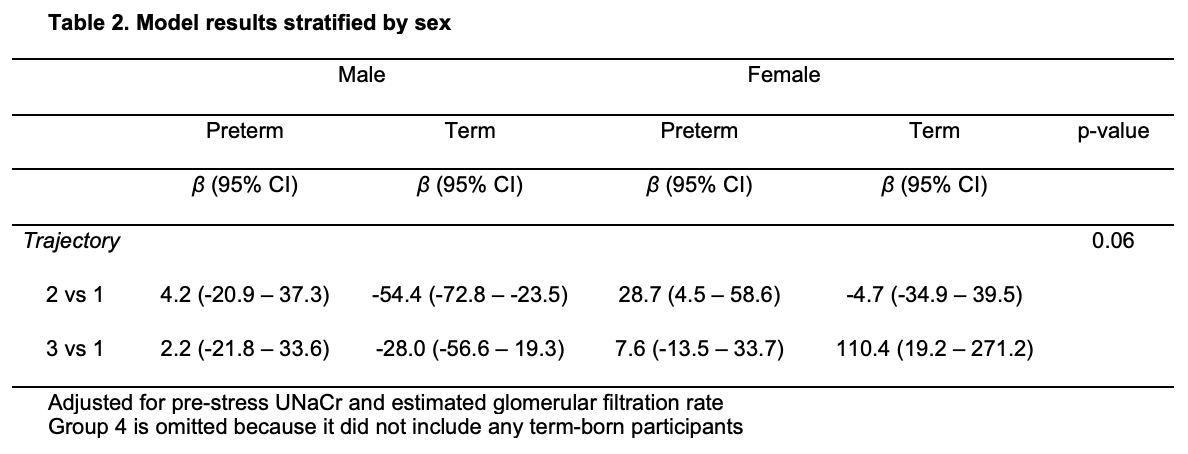Back
Background: Early-life programming due to prematurity and very low birth weight (VLBW; < 1500 g) contribute to later hypertension, with this effect amplified in females, but the underlying mechanisms are not fully known. Experimental data suggest that altered pressure natriuresis (an increase in renal perfusion pressure to promote sodium excretion) may be an important contributing mechanism. Adults with primary hypertension exhibit blunted pressure natriuresis in response to sympathetic arousal, but this has not been described in adults born preterm.
Objective: We hypothesize that young adults born preterm with VLBW will have a blunted pressure natriuresis response to mental stress compared to those born term.
Design/Methods: In this prospective cohort of 161 individuals aged 18–23 years, 129 (80%) born preterm with VLBW and 32 (20%) controls born term with birth weight >2500 g, we measured urine sodium/creatinine (UNaCr) before and after a 30-min mental stress test and non-invasive continuous blood pressure every 2 min prior to and during the stress test. We stratified participants into four groups based on their calculated mean arterial pressure (MAP) trajectory during the stress test, with the lowest trajectory designated the reference group. We used multivariable generalized linear models to assess the association of MAP trajectory with post-stress UNaCr and added an interaction term for preterm birth status, adjusted for pre-stress UNaCr and estimated glomerular filtration rate. We further tested for effect modification by sex.
Results: Study participants’ mean age was 19.8 years of whom 56% were female. Trajectory group 1 n=43 participants (70% preterm), group 2 n=67 (82%), group 3 n=60 (85%), and group 4 n=20 (100%). The preterm birth group demonstrated a smaller increase in UNaCr excretion per 1-mmHg increase in MAP compared to the term group (preterm 5.5%, 95% CI -11.5–25.3 vs. term 38.5%, 95% CI -0.04–92.0), interaction term p=0.002 (Table 1). When further stratified by sex, the preterm-term difference in pressure natriuresis was amplified in females as compared to males, with an interaction term of p=0.06 (Table 2).
Conclusion(s): We observed that, as BP increased under stress, individuals born preterm exhibited less sodium excretion relative to term-born individuals, and that this difference in effect was greater in females. This suggests that there may be a physiologic change in sodium handling that occurs as a result of preterm birth, and that this may lead to hypertension later in life among those born preterm. Ongoing investigation is needed to determine the underlying mechanism of this phenomenon.
.png)

Hypertension
Hypertension 2
16 - Altered Pressure Natriuresis in Individuals Born Preterm
Sunday, April 30, 2023
3:30 PM – 6:00 PM ET
Poster Number: 16
Publication Number: 16.322
Publication Number: 16.322
Nick Tully, Wake Forest School of Medicine of Wake Forest Baptist Medical Center, Winston Salem, NC, United States; Andrew M.. South, Wake Forest School of Medicine of Wake Forest Baptist Medical Center, Winston Salem, NC, United States
- NT
Nicholas Tully, BS (he/him/his)
Medical Student
Wake Forest School of Medicine of Wake Forest Baptist Medical Center
Winston Salem, North Carolina, United States
Presenting Author(s)
Background: Early-life programming due to prematurity and very low birth weight (VLBW; < 1500 g) contribute to later hypertension, with this effect amplified in females, but the underlying mechanisms are not fully known. Experimental data suggest that altered pressure natriuresis (an increase in renal perfusion pressure to promote sodium excretion) may be an important contributing mechanism. Adults with primary hypertension exhibit blunted pressure natriuresis in response to sympathetic arousal, but this has not been described in adults born preterm.
Objective: We hypothesize that young adults born preterm with VLBW will have a blunted pressure natriuresis response to mental stress compared to those born term.
Design/Methods: In this prospective cohort of 161 individuals aged 18–23 years, 129 (80%) born preterm with VLBW and 32 (20%) controls born term with birth weight >2500 g, we measured urine sodium/creatinine (UNaCr) before and after a 30-min mental stress test and non-invasive continuous blood pressure every 2 min prior to and during the stress test. We stratified participants into four groups based on their calculated mean arterial pressure (MAP) trajectory during the stress test, with the lowest trajectory designated the reference group. We used multivariable generalized linear models to assess the association of MAP trajectory with post-stress UNaCr and added an interaction term for preterm birth status, adjusted for pre-stress UNaCr and estimated glomerular filtration rate. We further tested for effect modification by sex.
Results: Study participants’ mean age was 19.8 years of whom 56% were female. Trajectory group 1 n=43 participants (70% preterm), group 2 n=67 (82%), group 3 n=60 (85%), and group 4 n=20 (100%). The preterm birth group demonstrated a smaller increase in UNaCr excretion per 1-mmHg increase in MAP compared to the term group (preterm 5.5%, 95% CI -11.5–25.3 vs. term 38.5%, 95% CI -0.04–92.0), interaction term p=0.002 (Table 1). When further stratified by sex, the preterm-term difference in pressure natriuresis was amplified in females as compared to males, with an interaction term of p=0.06 (Table 2).
Conclusion(s): We observed that, as BP increased under stress, individuals born preterm exhibited less sodium excretion relative to term-born individuals, and that this difference in effect was greater in females. This suggests that there may be a physiologic change in sodium handling that occurs as a result of preterm birth, and that this may lead to hypertension later in life among those born preterm. Ongoing investigation is needed to determine the underlying mechanism of this phenomenon.
.png)

